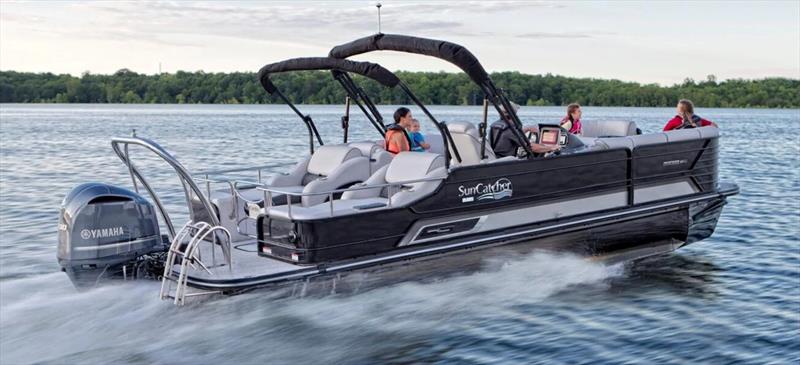
Performance report: Sharrow Props on G3 SunCatcher Elite 326
by Sharrow Marine 8 Feb 2024 12:34 PST

Sharrow Props on G3 SunCatcher Elite 326 © Sharrow Marine
Who said that toon owners don't care about performance? Au contraire! Pontoon boat owners bought their boats precisely because they want to fill the boat to the gills with friends! Trouble is, with a load even on a tri-toon, a single 300hp outboard will struggle. Happily, there's a solution.
By their very nature, pontoon boats are particularly sensitive to weight. Their 24" to 28" diameter pontoons have minimal displacement compared to a monohull boat. Ten guests averaging 160 lbs. equals 1,600 lbs. which increases the weight of an average 26' diameter pontoon tri-toon by 50%.
That sinks a tri-toon another 2" into the water, making it harder to get the boat up and semi-planning for a good turn of speed, and an exhilarating ride for all. Mushing along is not fun, and it can be wet depending on the wind direction and force.
The test numbers above were supplied to us by Sharrow Marine, which has a reputation for taking accurate test numbers on both their props and standard wheels. Their techs are instructed to follow the BoatTEST protocol for testing so that they can be confirmed by repeatable testing.
That protocol includes filling the fuel tanks to capacity for both the Sharrow prop and the conventional prop speed runs, keeping the boat weight the same, running reciprocal courses, and several other details that assure fair testing.
The test numbers above were recorded on a G3 326 tri-toon with 5 people aboard.
Note that the tri-toon first broke away from the conventional prop curve at 2500 RPM, which is typical. It is here that the advance rate of the Sharrow loop prop was able to create significantly more thrust than the standard prop, which was still suffering from massive slip.
The above chart of the advance rate of each prop explains exactly why the boat performs as it does with each of the two props. Let's look at the advance rate for each prop at 2500 RPM.
As can be seen, the standard prop is advancing only 9.46 inches for every 360-degree revolution of its 15" pitch prop. Theoretically, it should advance 15." On the other hand, the Sharrow prop, because its design has greater grip on the water, is advancing 12.68 inches for every complete revolution, instead of the theoretical 16."
The Sharrow prop is advancing 3.22 inches farther with each revolution than the standard prop. Neither prop is perfect (which is unattainable), but the Sharrow prop's advance rate is considerably greater than the old technology prop.
That is 34% more advance than the standard prop for every 360-dgree revolution. That advance rate dichotomy continues up the RPM and speed scale, hitting a maximum at 37% at 3000 rpm and 21 mph, where many boaters like to cruise because it is the apex of fuel economy which can be seen below.
The Sharrow prop is more fuel efficient at all but three of the data points above. Pick your preferred speed and see the relative fuel burns.
Our take away is that because the Sharrow props produce greater thrust in the mid RPM range, its props will be better suited for both light and heavy guest weights. While its fuel consumption is 26% less at 25 MPH, we think its greatest attribute will be the ability of handling a boat full of guests at exciting cruising speeds that cannot be achieved by standard, old technology props.
Our products are compatible with a number of outboard and sterndrive applications. You can schedule a free consultation with one of our customer support representatives to find out how the Sharrow Propeller will benefit your vessel operating experience: sharrowmarine.com/support
Or send us an email with your boat and engine information and we will get back to you with what might be available: support@sharrowmarine.com